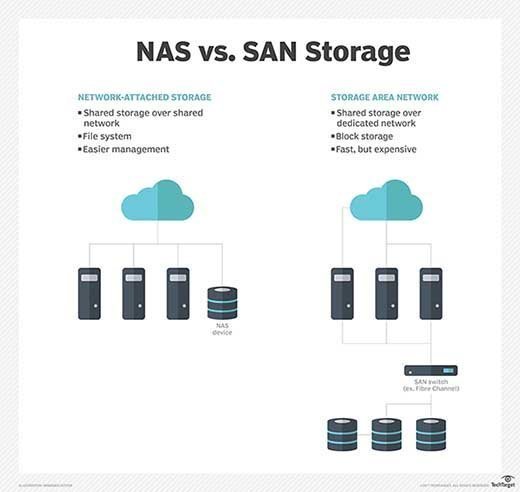storage filer
What is a storage filer?
A storage filer is a type of file server designed and programmed for high-volume data storage, backup and archiving. However, the terms storage filer and file server are sometimes used interchangeably, without the "high-volume" qualifier. Storage filers might also be referred to as storage file servers, whether or not they're specific to high-volume workloads.
Storage filers come in many forms and sizes, including network-attached storage (NAS) filers and storage area network (SAN) filers. In the early days of storage vendor NetApp -- then called Network Appliance -- the company offered the NetApp Filer, a file server appliance that eliminated the overhead traditionally associated with competing storage products. Those early systems should not be confused with today's NetApp products, which are still sometime referred to as NetApp filers because they're sold by NetApp and include filer services.
These days, vendors tend to shy away from the term storage filer, although they continue to use "filer" in various ways. They're also opting for broader descriptors such as scale-out file-based storage, but conceptually the idea remains the same -- to centralize file services in support of data sharing across Ethernet LANs, SAN networks or the internet, and often extending these services to cloud platforms or edge environments.

Today's storage filers
The concept of a storage filer has evolved over the years to include a wide range of products, although vendors continue to sell products that conform to a more traditional concept of a storage filer. For example, Dell EMC offers a variety of PowerScale NAS systems that can serve as storage filers. Some of these systems can store petabytes of file data, such as the Isilon H5600, which can scale up to 1.28 petabytes (PBs) of raw data per chassis, while delivering 8 GBps bandwidth, according to Dell.
NetApp also continues to offer storage filer products, although they're much more capable and with greater capacities than the original NetApp Filers. For instance, the NetApp FAS2600 series hybrid storage systems can now manage petabytes of data. The systems can support both NAS and SAN workloads and store over 17 PB of raw capacity when deployed in a scale-out configuration.
The concept of a storage filer is no longer limited to traditional on-premises systems. Panzura, for example, offers its Freedom NAS Filer platform, a software-defined storage product that can connect file data across private and public clouds, with a maximum addressable cloud storage size of up to 27.4 PB of data. Buurst Inc. sells a similar product, SoftNAS, a software-defined NAS filer delivered as a virtual appliance for public, private and hybrid clouds.
The storage filer concept has also worked its way to the edge. For example, Microsoft now offers Azure FXT Edge Filer, a hybrid storage service for optimizing hybrid storage across data center NAS systems, remote office NAS systems and Azure Blob Storage. The service is delivered through a combination of hardware and software in order to provide the throughput and low latency necessary to support high-performance computing (HPC) workloads. CTERA also offers a variety of edge storage filer systems as part of its Edge H Series, which provide remote file storage to meet distributed enterprise file storage requirements.
The best storage filers are characterized by the following features and characteristics:
- around-the-clock availability
- scalability/expandability
- independent programming
- ease of management
- support for multiple network protocols
- high storage capacity
- storage redundancy
- high throughput
- security features
- connectivity to a variety of backup device types and configurations
Costs can range from a few thousand dollars to over $100,000 for an on-premises system, although many organizations are now opting for consumption-based pay-as-go services, whether on premises or in the cloud.







